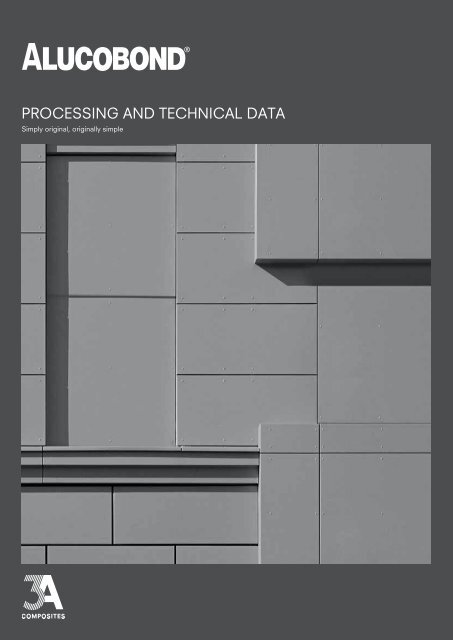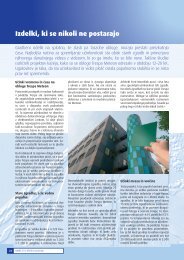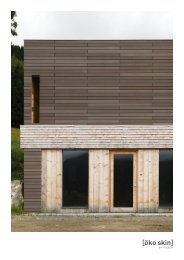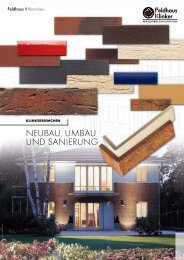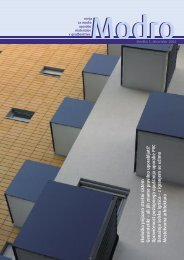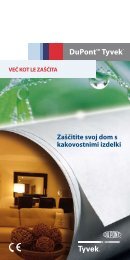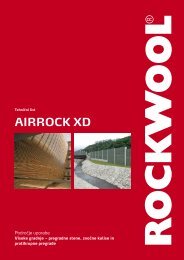ALUCOBOND Verarbeitung - Ravago
ALUCOBOND Verarbeitung - Ravago
ALUCOBOND Verarbeitung - Ravago
- No tags were found...
Create successful ePaper yourself
Turn your PDF publications into a flip-book with our unique Google optimized e-Paper software.
PROCESSING AND TECHNICAL DATASimply original, originally simple1
CONTENTSTRANSPORTATION, STORAGE4 GeneralPANEL DIMENSIONING5 GeneralPANEL INSTALLATION6 GeneralINFORMATION ON SPECIAL SURFACES7 Anodised, naturAL, mill-finished surfacesPROCESSING METHODS9 Sawing11 Routing12 Water jet cutting12 Punching / shearing13 BendingROUTING AND FOLDING TECHNIQUE15 General16 Machines17 Tools19 Fabrication of tray panels21 Fabrication of attica corners 90° in two segmentsJOINTING / FIXING TECHNIQUE24 General24 Thermal expansion and contraction25 Drilling / countersinking26 Riveting27 Screwing28 Gluing31 ClampingSURFACE TREATMENT32 GeneralCLEANING AND MAINTENANCE33 General33 Removal of graffitiFACADE - STANDARD DESIGNS35 GeneralTECHNICAL DATA SHEETS37 <strong>ALUCOBOND</strong> ®38 <strong>ALUCOBOND</strong> ® plus39 <strong>ALUCOBOND</strong> ® A2INTERNET ADDRESSES, INFORMATION, CREATE THE DIFFERENCE40 Internet addresses42 Information43 Create the differenceEdition 1<strong>ALUCOBOND</strong> ® Processing and Technical Data GB3
TRANSPORTATION, STORAGE1.00 m– 1.20 mSet maximum fork widthPick up the pallet, slightly raise the forkPick up the complete pallet, do not drawnor pushGeneralTo protect <strong>ALUCOBOND</strong> ® composite panels against mechanical damagesand the harmful effects of weather conditions and moisture, the followinginformation must be observed:--The pallets must be handled carefully during transport and unloading.(Caution: Do not handle open pallets).--Upon delivery the pallets must be examined for any damage due totransportation and moisture (<strong>ALUCOBOND</strong> ® panels that have becomewet must be dried to avoid any spots or corrosion forming). Any damagemust be reported immediately and confirmed by the forwarding agent.--Store the pallets so that they are protected against any wetnesspenetrating due to rain and spray water and avoid any condensationforming (e.g. when transporting cold panels to warmer rooms).--Store the pallets stacked one over the other (do not store <strong>ALUCOBOND</strong> ®panels standing vertically) with a maximum of 6 pallets of the sameformat stacked on top of each other (heavy pallets at the bottom).--Individual panels must be lifted off the pallet by two people holding allfour corners and not drawn over each other. Carry the panels vertically.Wear gloves to avoid staining.--When stacking panels, nothing should be put in between to avoidmarkings.To ensure perfect functioning of the <strong>ALUCOBOND</strong> ® protective film, thefollowing information should be observed:--Storage exceeding 6 months should be avoided. Severe temperaturefluctuations and exposure to direct sunlight reduce the long-termdurability. In this case the protective film may become very difficultto remove.--Do not mark the protective film with inks (markers), tapes or labels.Solvent or plasticizer may penetrate the film and affect the lacqueredsurface.--Should the protective film partially come off during processing or afterassembly, dirtied edges can occur in the course of time, which maybe difficult to remove.--Remove the protective film as soon as possible after assembly.Protective film that remains on the panels for an extended period ofexterior exposure may be very difficult to remove.--Make sure not to remove the protective film at temperatures below 10°C.4 Edition 1 <strong>ALUCOBOND</strong> ® Processing and Technical Data GB
PANEL DIMENSIONINGWHEN DIMENSIONING THE PANELS, THE FOLLOWING SHOULDBE NOTEDDimensional tolerancesThickness ±0.2 mmWidth -0 / +4 mmLength 1000 – 4000 mm -0 / +6 mmLength 4001 – 8000 mm -0 / +10 mmWhen cutting and routing, the thermal expansion in length of <strong>ALUCOBOND</strong> ®must be taken into account to ensure the dimensional accuracy of thecomponents during assembly. We recommend that prior to processingthe panels should be stored at room temperature for at least one day.Panel edgesDue to the manufacturing process a lateral displacement of the coversheets of max. 2 mm is possible at the panel edges.Anodised contact linesAnodised <strong>ALUCOBOND</strong> ® composite panels have contact lines on theshort sides - of up to 25 mm width on the front and up to 35 mm widthon the back.With panel lengths of more than 3.5 m, contact lines of up to 20 mm widthmust also be taken into account at the longitudinal edges.TrimmingThe panels have to be trimmed:--on all sides, to ensure accurate rectangularity and precisely cut edgeswhen using raw edges, such as e.g. with the riveted façade version.--on three sides, to ensure accurate rectangularity for further processing.The trimming cuts must be taken into account when dimensioning thepanel.Static calculation of elements--For static values, please see the Technical Data Sheets--For static tables, please ask for detailsEdition 1<strong>ALUCOBOND</strong> ® Processing and Technical Data GB5
PANEL INSTALLATIONProtective film with direction arrowsWHEN INSTALLING THE PANELS, THE FOLLOWING SHOULD BE NOTEDAssembly directionTo avoid possible reflection differences (for metallic, special effect,naturAL, and Spectra colours), we recommend that the composite panelsshould be installed in the same direction as marked on the protective film.Colour variations may occur between panels originating from differentproduction batches. To be sure of homogeneous colouring, the totalrequirement for a project should be ordered in one batch, i.e. the frontof a building should be composed of panels of one batch only (see palletlabel or stamp on the reverse side).3A Composites GmbHAlusingen-Platz 178224 SingenGermanyBatch No. on the reverse sideBatch No. on the pallet labelFixing elements without jammingLinear expansion coefficient of <strong>ALUCOBOND</strong> ® 2.4 mm/m/100°C--The minimum gap depends on the expected expansion of the panel--Larger hole diameters in the panel must be taken into account whenfixing the panel with screws and rivets--Holes in the panel and in the substructure must be drilled centrically(use drilling jigs)--Distance between panel and rivet head 0.3 mm (use rivet attachment jigs)--Be careful not to over-tighten the screws on the panel--Arrange the butt joints of the supporting sections at the panel jointsto avoid jamming due to opposing thermal expansionHole inthe substructureSPSPSPSPHole in the panelCentrical drillingFPFPFPFPFixed points and sliding points--For fixing the supporting sections, pay attention to fixed point holders(FP) and sliding point holders (SP).--Joints in the substructure must be taken into account when fixingSPSPSPSPfacade elements. They must not be skipped, i.e. the façade elementsmust not be fixed to the lower or upper supporting section!Butt joint of supporting section = panel joint6 Edition 1 <strong>ALUCOBOND</strong> ® Processing and Technical Data GB
INFORMATION ON SPECIAL SURFACESAnodised surfacesDuring the anodising process an artificial oxide layer is produced on thealuminium surface. This takes place in a liquid medium with a definedbath composition under direct and alternating current.Thanks to their resistance to corrosion and their decorative effect, anodisedaluminium parts are successfully used on a large scale, particularly forexterior and interior applications. These properties, however, are onlyretained for a longer period, if a sufficiently thick oxide layer has beenbuilt up and is well compacted on an aluminium material that is suitablefor anodising. Additionally, the elements must be cleaned in such a waythat the corrosive impact is also taken into account.Based on all the measurements taken with regard to exterior applications(e.g. facades / windows) we can say that the reduction in the thickness ofthe oxide layer is so minimal – even over a longer period of 30 years – thatthis in no way jeopardizes the protective effect of anodic, oxide layers.According to DIN 17611, anodised <strong>ALUCOBOND</strong> ® and <strong>ALUCOBOND</strong> ® pluscomposite panels are anodised, semi-finished products made of aluminiumwith an anodised layer thickness of at least 20 µm for exterior applications.Quality assurance during the production of the panels according toDIN EN ISO 9001, ensures a high-quality, final product.Whereas microcracks occur in the deformed area when bending andfolding anodised panels, stove-lacquered <strong>ALUCOBOND</strong> ® anodized-lookcomposite panels can be folded and bent without any problem, as thesurfaces are designed to comply with the EURAS industrial standards.naturAL surfaces3A Composites has introduced an innovative coating – <strong>ALUCOBOND</strong> ® naturAL– that permanently preserves the natural, aluminium surface. During therolling process this allows “brushed” structures to be produced, forexample, with a clearly higher surface brilliance than we know of stainlesssteel. The surface is not only weather-resistant but also insensitive toperspiration (finger prints). In highly corrosive environments (e.g. nearthe coast or in an industrial atmosphere) the cleaning intervals must beincreased, accordingly. In most cases, clean water will then be sufficientfor cleaning and will prevent accumulation of salt or any other pollutants.Owing to the production process, <strong>ALUCOBOND</strong> ® naturAL Reflectproduces a slightly iridescent effect in artificial light. Therefore, for interiorapplications – please inquire – a Reflect surface with a modified structuremay be advisable. Due to the high degree of reflection of the underlyingsurface – as compared to conventionally pigmented lacquering – thecoating is exposed to almost double the UV radiation. For this reason,the resistance of <strong>ALUCOBOND</strong> ® naturAL surfaces is reduced in the caseof inclined planes and applications between latitudes of 20°N and 20°S.Edition 1<strong>ALUCOBOND</strong> ® Processing and Technical Data GB7
INFORMATION ON SPECIAL SURFACESMill-finished surfacesWhen using <strong>ALUCOBOND</strong> ® panels with mill-finished surfaces that arenot protected from atmospheric influences through coating or anodising,a variation in the appearance of the aluminium surface must be takeninto account.The untreated, mill-finished aluminium surface – on which no decorativedemand should be made, acquires a natural oxide layer; in the courseof time the thickness increases to approx. 0.1 µm under the influence ofthe outer atmosphere.When coated with reaction products, the surface shows a reducedreflectivity compared to its state when new, i.e. the surface loses itsmetallic brilliance taking on a dull, light-grey appearance. This impressionis enhanced by dirt sedimentation in and on the surface. However, thisgreying is frequently viewed as positive.Whereas the reactions of uncoated aluminium to atmospheric influenceschange the appearance of the surface, the stability of the <strong>ALUCOBOND</strong> ®panel is not impaired, as the reactions only have an effect on the panelsurface, and the oxide layer protects the material underneath from anyfurther corrosion.It is virtually impossible to clean untreated, aluminium construction parts inexterior architecture, but this is not necessary as a rule, due to the readilyaccepted surface change and also its high resistance to weathering.The protective film should not be removed until all the necessary workhas been completed. After removal, make sure to wear gloves, as thiswill avoid leaving any finger prints that are almost impossible to removeafterwards.8 Edition 1 <strong>ALUCOBOND</strong> ® Processing and Technical Data GB
PROCESSING METHODSWhen ordering new machines or pole-changing saw motors and forretrofitting to dustproof bearings, please contact Striebig AG directly,stating the year of construction, type and serial number of the machine.DUST EXTRACTOR SYSTEMS FOR CIRCULAR PANEL SAWSFor sawing and routing <strong>ALUCOBOND</strong> ® A2 and <strong>ALUCOBOND</strong> ® plus werecommend the following dust extractor systems:--AL-KO POWER UNIT 200P/250P for <strong>ALUCOBOND</strong> ® A2 and<strong>ALUCOBOND</strong> ® plus (mobile system)--AL-KO ECO-JET 3A/3A XL (stationary system)Important when ordering: With ECO-Jet standard systems the connectingbranch is arranged on the right-hand side. Other branch sides pleasespecify when ordering.--SCHUKO Vacomat 200XP (mobile system) with special equipment for<strong>ALUCOBOND</strong> ® A2 (please specify when ordering)Tooth geometry trapezoid/flat toothSAW BLADES FOR CIRCULAR PANEL SAWSSaw blades for <strong>ALUCOBOND</strong> ® (LEUCO)--carbide tipped circular saw blades, trapezoid/flat tooth--flat teeth 45° chamfered for burr-free edges--saw blade – Ø = 300 mm for Striebig saw, type Standard II:--t = 72 (for stack cutting), purchase order No. 181724--t = 96 (for neat, burr-free single cuts), purchase order No. 1811725--saw blade – Ø = 250 mm for Holz-Her saw, type PK 1255--t = 60 (for stack cutting), purchase order No. 181726--t = 80 (for neat, burr-free single cuts), purchase order No. 181727--bore – Ø = 30 mm--tooth thickness 3.2 mm--clearance angle 15°--rake angle 10° positive--speed 5,000 rpm--maximum feed 30 m/minStack cuttingSaw blades for <strong>ALUCOBOND</strong> ® plus and <strong>ALUCOBOND</strong> ® A2 (Speiser)--carbide tipped circular saw blades, trapezoid/flat tooth--suitable for speed 2,500 rpm--flat teeth 45° chamfered--saw blade – Ø = 300 mm for Striebig saw, type Standard II,purchase order No. 07060651--saw blade – Ø = 250 mm for Holz-Her saw, type PK 1255,purchase order No. 02040151--bore – Ø = 30 mm--number of teeth t = 72 (Ø = 300 mm)--number of teeth t = 60 (Ø = 250 mm)--tooth thickness 3.2 mm--clearance angle 15°--rake angle 10° positive10 Edition 1 <strong>ALUCOBOND</strong> ® Processing and Technical Data GB
PROCESSING METHODS--speed 2,400 rpm (= ½ speed with panel saws of Striebig and Holz-Her by means of pole-changing saw motors, see ordering/retrofittingmachines)--feed, single cut 25 m/minstack cut 20 m/min (3 – 4 panels)Sketch showing the edge geometry for professional re-sharpeningSAWING WITH HAND-HELD CIRCULAR SAWSMachine--With regard to the cutting speed, the following hand-held circular sawis suitable for processing <strong>ALUCOBOND</strong> ® :--FESTOOL hand-held circular saw, type TS 55 EB Q-Plus-FS,speed 2,000 – 5,200 rpmWith <strong>ALUCOBOND</strong> ® plus and <strong>ALUCOBOND</strong> ® A2 please pay attentionto the speed reduction!Tools are not included in the scope of supply. Please order separately:--FESTOOL carbide tipped saw blade, trapezoid/flat tooth, rake anglepositive, saw blade – Ø 160 mm, t = 48, purchase order No. 496308Sawing WITH JIG SAWSMachineUse hand-held jigsaws with pendulum strokeTools – <strong>ALUCOBOND</strong> ®Saw blades for wood and plastics, tooth pitch = 2.5 mm for precision cuts,e.g. Bosch saw blade T101BTools – <strong>ALUCOBOND</strong> ® plus and <strong>ALUCOBOND</strong> ® A2Saw blades for aluminium, tooth pitch = 2 mm, e.g. FESTOOL saw bladeHS 60/2 biJig saw bladesROUTING<strong>ALUCOBOND</strong> ® can be easily routed on conventional routing machinesand CNC machining centres. To avoid pressure marks on the surface,please use plastic or wood vice jaws when chucking the work-pieces.Preferably use vacuum tables with MDF boards as sacrificial boards.Edition 1<strong>ALUCOBOND</strong> ® Processing and Technical Data GB11
PROCESSING METHODSCarbide tipped cutters suitable for aluminium and plastics are alsosuitable for <strong>ALUCOBOND</strong> ® . Perfect cuts are produced, e.g. under thefollowing conditions: feed 5 m/min., speed 24,000 rpm.Cutter Cutter with withright-hand twist twistCutter Cutter with withright-hand twist twistwaste wastego-sidefeedfeedfeedfeedwork-piecego-sidework-piecewaste wasteSingle flute cutter with right-hand twistPanel = work-piece, feed in clockwisedirectionCut shape = work-piece, feed in anticlockwisedirectionSuitable cutters for contour cutting of <strong>ALUCOBOND</strong> ® :--Single flute cutter, series F113 (GIS )--solid carbide metal--right-hand twist--polished flute(1)(2)Water jet cuttingCut abrasively when using a water jet cutting machine. Pre-drilling ofthe panels is necessary when starting the cut in the middle of a panelas it is not possible to drill through with the water jet. For clean cutedges, the routing method should preferably be used.(3)(1) <strong>ALUCOBOND</strong> ® , (2) <strong>ALUCOBOND</strong> ® plus,(3) <strong>ALUCOBOND</strong> ® A2Punching / shearingPunching<strong>ALUCOBOND</strong> ® panels of any thickness can be punched using conventionalsheet metal punching machines. For clean cuts use sharp tools anddies with minimal cutting clearance (0.1 mm). This cutting process willcause a slight deflection of the cover sheet.Multi-station machines (Liechtblick)Series punching of, for example, tray panels can be realised efficientlyusing multi-station machines.Multi-station machinePerforating (for interior applications only)<strong>ALUCOBOND</strong> ® panels can be perforated using CNC punching machines.This is often used for interior and ceiling design. Holes of a minimumdiameter of 4 mm can be punched. The minimum width of web betweenhole edges is also 4 mm. The best results will be obtained using a punch12 Edition 1 <strong>ALUCOBOND</strong> ® Processing and Technical Data GB
PROCESSING METHODSdie for single punching. Multi-station machines are more economical.After punching, the flatness will possibly require further processing.min. 4 mmdeflection ofcover sheetpunchScherenmin. 4 mmdieclearance 0.1 mmPunching tray panelsShearing<strong>ALUCOBOND</strong> ® can be sheared with a conventional guillotine. A shearingangle of ≤ 1,5° and minimum clearance (paper test) are the prerequisitesfor the best possible quality of the cut.Punching holesTo prevent damage to the cover sheet, it is appropriate to provide thedown-holders of the guillotine with protective rubber pads.Important: For applications with visible cut edges (e.g. riveted facades),shearing of <strong>ALUCOBOND</strong> ® does not satisfy decorative demands and,therefore, should be avoided.BENDING<strong>ALUCOBOND</strong> ® can be formed by conventional metal fabrication methods.Certain specific points should be noted relating to the multilayer structurecombining materials of different properties:--the minimum bending radius is for<strong>ALUCOBOND</strong> ®, <strong>ALUCOBOND</strong> ® plus r = 10 x d<strong>ALUCOBOND</strong> ® A2r = 25 x d<strong>ALUCOBOND</strong> ® naturALr = >_ 60 mm<strong>ALUCOBOND</strong> ® naturAL Reflect r = >_ 200 mm(d = panel thickness)The spring-back effect experienced when folding sheet metal is largerwith <strong>ALUCOBOND</strong> ® . For production series a prototype should be made.To prevent the surfaces from being damaged, the protective film mustnot be removed during processing. Additionally, the visible surface canbe protected by using plastic pads of 1 – 2 mm thickness.Attention: When bending <strong>ALUCOBOND</strong> ® with an anodised surface, thebent area is brighter.Edition 1<strong>ALUCOBOND</strong> ® Processing and Technical Data GB13
PROCESSING METHODSBending with a roll bending machine<strong>ALUCOBOND</strong> ® can be bent using sheet metal roll bending machines– mainly with three and four-roll machines. Please make sure that thefeeder does not exert too much pressure.Bending rollers which are also used for bending other metals must bethoroughly cleaned from swarf before processing <strong>ALUCOBOND</strong> ® . Werecommend ground rollers to avoid damaging the cover sheets.Rounded elements and edges (e.g. tray panels) can be bent using specialroll bending machines. The depth of the edge depends on the radius.Please ask for details.Elements rounded / foldedBending with a roll bending machineprotective filmdBending with a brake press<strong>ALUCOBOND</strong> ® , like sheet metal, is easily formed with a brake press. Theair-bending process is used when forming with a brake press.diedie widthThe <strong>ALUCOBOND</strong> ® panel rests on the edges of the die (rails, U-sections)and is bent by the punch (tube or shaft). The bending angle is determinedby the width of the die and the stroke of the punch. The die edges shouldbe rounded and smooth.Bending with a brake pressprotective filmdIdeal die width:2 x d + 2 x protective film thickness + punch diameter + 15 mmupperclampingcheekformerupperclampingcheekBending with a folding machineswivel barThe minimum side length of the bent part should be 5 times the<strong>ALUCOBOND</strong> ® thickness.Bending with a folding machineWhen working with folding machines, the panel to be bent is clampedbetween two cheeks. The projecting edge is bent around the upperclamping cheek or former using the movable swivel bar. The bendingradius is determined by interchangeable formers attached to the upperclamping cheek.14 Edition 1 <strong>ALUCOBOND</strong> ® Processing and Technical Data GB
ROUTING AND FOLDING TECHNIQUEGeneral--<strong>ALUCOBOND</strong> ® composite panels can be shaped by means of asimple processing technique. This procedure, the routing and foldingtechnique, enables a variety of shapes and sizes to be manufactured.----V-shaped or rectangular grooves are routed on the rear of the<strong>ALUCOBOND</strong> ® panels using disk or end milling cutters, whereby thealuminium cover sheet at the front and part of the polyethylene coreare retained. The small thickness of the remaining material then allowsfolding by hand. A brake press is not required. The groove shapedetermines the bend radius. The grooves can be produced with a panelsaw with routing device for <strong>ALUCOBOND</strong> ® , on a CNC machiningcentre, with a panel routing machine or a hand routing machine. Therouting and folding technique can be used for composite panels ofall standard surfaces.Routed / folded elementsAdvantages--The convincing advantages of the routing and folding technique are:--Minimum investment--Simple operating technique--Folding need not be done in the workshop, it can be done on site; thismeans low transport costs--Low-cost manufacture of shaped parts like façade elements, frames,fascia claddings and roof edgings, corner pieces and many more arepossible--Versatile formability--Good economy--Shapes are not restricted by machine dimensions.--Tension-free folding, therefore no buckling in the corner area and thuseven elements.Groove (V-shaped) for edges up to 90°Groove (V-shaped) for edges up to 135°Rectangular groove for edges up to180° depending on panel thicknessNot suitable for <strong>ALUCOBOND</strong> A2r = 3 mmr = 3 mmr = 7 mmImportant: With <strong>ALUCOBOND</strong> ® with anodised surface and <strong>ALUCOBOND</strong> ® with naturAL Reflect surface, theformation of micro-cracks leads to brightening in the edges.Edition 1<strong>ALUCOBOND</strong> ® Processing and Technical Data GB15
ROUTING AND FOLDING TECHNIQUEMACHINES FOR ROUTING AND FOLDING TECHNIQUEVertical panel saws with routing device for routing <strong>ALUCOBOND</strong> ®(special accessory)--Holz-Her vertical panel saw, PK 1255 <strong>ALUCOBOND</strong> ®--Striebig, vertical panel saw, Standard II for composite panelsOther panel saws with a special routing device can also be supplied orretrofitted by the manufacturer. If necessary, the frame has to be raised.For inquiries relating to--new machines with accessory parts for routing <strong>ALUCOBOND</strong> ®--possible retrofitting of existing machines (stating machine type/No.and year of construction)--accessories such as cutter disks, tracing rollers, etc.Please contact the manufacturer of the panel saws.Important: For inquiries and orders, please add “for processing<strong>ALUCOBOND</strong> ® composite panels”.Important:General information regarding the routing and folding technique--Processing temperature: During folding, the ambient and materialtemperature should not be below 16°C (see also DIN EN 1396).For <strong>ALUCOBOND</strong> ® plus and <strong>ALUCOBOND</strong> ® A2--Tracing rollers: Make sure to use tracing rollers with dustproof bearings.--Speed 2,400 rpm (= ½ speed with panel saws of Striebig and Holz-Her)--Feed max. 20 m/min. Pay attention to a constant feed.--Routing of rectangular groove not possible.CNC machining centres<strong>ALUCOBOND</strong> ® can be processed easily on CNC machining centres.Depending on the equipment of the machines, various processing stepscan be performed: sawing, milling (routing and folding), contour cutting,drilling.16 Edition 1 <strong>ALUCOBOND</strong> ® Processing and Technical Data GB
ROUTING AND FOLDING TECHNIQUEMACHINES FOR ROUTING AND FOLDING TECHNIQUEFestool panel routing machine PF 1200 E-Plus <strong>ALUCOBOND</strong> ®Supplied with:--Tracing roller for 4 mm--Cutter disk for V-grooves 90°--Adjustment template--Transport boxHand routing machinesCommercially available hand routing machines with a minimum rating of800 W are suitable. Collet chucks 8 mm dia.Panel routing machine PF 1200 E-PlusMobile dust extractorsE.g. Festool mobile dust extractors, types CTM approved for dust classM for dust with MAK values > 0.1 mg / m³ for sheet milling machines,hand routers and hand-held circular saws.TOOLS FOR ROUTING AND FOLDING TECHNIQUECarbide tipped disk milling cutters for vertical panel sawsWith a nominal panel thickness, the diameters of tracing rollers andcutter discs are adjusted so as to leave a residual core thickness of0.3 mm (V-groove) or 1 mm (rectangular groove). The dimensions givenin the drawings show the cover panel thickness of 0.5 mm plus thecorresponding residual core thickness.For inquiries relating to disc milling cutters with indexable inserts suitablefor processing <strong>ALUCOBOND</strong> ® plus and A<strong>ALUCOBOND</strong> ® A2 for Holz-Herpanel saws (type PK 1255 <strong>ALUCOBOND</strong> ® , number of teeth = 8, cutterdisk outer dia. = 244 mm), please contact Reich, Holz-Her or LEUCO.For ordering disk milling cutters with indexable inserts V-groove 90° andV-groove 135° as well as the corresponding tracing rollers for all typesof Striebig panel saws, please contact Striebig AG.When ordering please state type of panel saw and year of construction.Edition 1<strong>ALUCOBOND</strong> ® Processing and Technical Data GB17
ROUTING AND FOLDING TECHNIQUECarbide tipped disk milling cutters for vertical panel sawsDisk milling cutter for V-grooves 90° Disk milling cutter for V-grooves 135° Disk milling cutter for rectangular groovesMilling cutters with cylindrical shank for hand routing machinesEnd milling cutter for V-grooves 90°Carbide tipped cutter No. 491 444 (Festool)Carbide tipped cutter No. FV09.01.090 (GIS )Carbide tipped cutter No. 79 803 (KWO)End milling cutter for V-grooves 135°Carbide tipped cutter No. 491 443 (Festool)Carbide tipped cutter No. FV09.01.135 (GIS )Carbide tipped cutter No. 79 804 (KWO)End milling cutter for rectangular groovesHSS cutter Ø 10 mm No. 79800(KWO)HSS cutter Ø 15 mm No. 79801(KWO)18 Edition 1 <strong>ALUCOBOND</strong> ® Processing and Technical Data GB
ROUTING AND FOLDING TECHNIQUEFabrication of tray panelsDetermination of the measures of periphery and routing measuresThe measures of periphery and the routing measures are determined onrouting measurethe basis of the drawing measures (final measures). In this case, approx.approx.approx.1 mm per edge is deducted from the final measure. 1 mm The total of the 1 mm routingmeasures results in the cutting measure. In any case, final the measure final measuresshould be checked using a test strip prior to series production. Thenthe limit stops of the panel saw can be adjusted to obtain elements ofidentical sizes.Determination of the cutting measureExample <strong>ALUCOBOND</strong> ® roof edge:Total of routing measures = cutting measure = 1292 mmfinal measurerouting measureapprox.1 mm300 final measure298 routing measurecut off the completemilled grooveapprox.1 mmrouting measurefinal measureapprox.1 mmfinal measurerouting measure800 final measure798 routing measure50 final measure49 routing measureapprox.1 mm50 final measure49 routing measure100 final measure098 routing measurecut off thegroove basepunching upto centre ofmilled grooveV-groove90°For dimensionsrelating to traypanels, pleasesee examples“Suspendedtray panels”Determination of the routing measureAdjustment of punch depth300 final measure298 routing measureAdjustment of the punching depth when punching cornersIn order to obtain perfectly closed tray corners, the machine settingsindicated in the sketch must be observed.800 final measure798 routing measure50 final measure49 routing measure50 final measure49 routing measureFor clean cuts use sharp tools and dies with minimal cutting clearance(~ 0.1 mm).4final measure10routing measure82Bending aids100 final measure098 routing measureFor easy folding of <strong>ALUCOBOND</strong> ® , particularly in the case of narrowfolds processed according to the routing and folding technique, werecommend bending aids that can be produced of <strong>ALUCOBOND</strong> ® buttjoint sections and panel strips.--Butt joint section4 mmSection No. 31343--Butt joint section6 mmSection No. 31344Minimum double folds<strong>ALUCOBOND</strong> ®panel stripEdition 1<strong>ALUCOBOND</strong> ® Processing and Technical Data GB19
ROUTING AND FOLDING TECHNIQUEFolding sequence for fabricating tray panels(1) Cut V-grooves according tothe above instructions(2) Fold the narrow sidemore than 90°(3) Fold back to a little morethan 90° and slightly foldthe triangle(4) Fold the triangle togetherwith the longitudinal edge(5) Folding the upper edgesOwing to the pre-stressingwhen folding more than 90°,the two edges of theV-grooves fit tight.20 Edition 1 <strong>ALUCOBOND</strong> ® Processing and Technical Data GB
ROUTING AND FOLDING TECHNIQUEFabrication of attica corners 90° in two segmentsFor further examples relating to roof edges and fascia cladding please see theCD “Architecture in detail”Connection of folds, 30 mm,Section No. 24 569Example: Determination of the measure of periphery24224214210010045°200100.41005°200 100.4 100135° groove14290°groove90° groove90° groove142 100section A–A242top viewmeasure of peripheryRouting the folding grooves on vertical panel sawsHorizontal adjustmentof saw unit12090° groove (or 135°)135° groove2<strong>ALUCOBOND</strong> ® support21 1Secure the element againsttipping by clamping it tothe <strong>ALUCOBOND</strong> ® supportBearbeitungschritteEdition 1<strong>ALUCOBOND</strong> ® Processing and Technical Data GB21
ROUTING AND FOLDING TECHNIQUEProcessing steps(1) Marking the measures on thereverse side of the two cornerparts according to the exampleon page 1990° groove90° groove90° groove(2) Vertical routing of the measuresof periphery30(3) Precisely cut off the contoursalong the outer line of the fold(centre line of groove + 30 mmfold depth) using a jig saw.When doing so make sure toclamp together the front sidesof the two corner pieces.milled groove –centre lineboth cornerpieces clampedtogether22 Edition 1 <strong>ALUCOBOND</strong> ® Processing and Technical Data GB
ROUTING AND FOLDING TECHNIQUE(4) Routing the grooves parallel tothe cut edges at a distance of30 mmmilled groove90° or 135°milled groove135°(5) Notching the folds using a90° notcher(6) Assembly- Insert the sealing tape2 x 30 mm made of PE orneoprene- Connect the two cornerpieces in the vertical areawith section 24 569- Rivet the edging section tothe folds- Bend the folds and inclinedparts- Unfold the corner element- Join the folds in the inclinedarea by folding up section24 569 verbinden- Additionally secure theelement by screwing thefoldsaluminiumblind rivetsection 24 569Edition 1<strong>ALUCOBOND</strong> ® Processing and Technical Data GB23
JOINTING / FIXING TECHNIQUEmin.15 mmDistances from the edgemin. 15 mmGeneralTo avoid any tension occurring in the rivet and screw connections, therivets and screws must be set tension-free. The bore holes in the panelsmust be large enough to allow for the expected thermal expansion. Thelinear, thermal expansion of <strong>ALUCOBOND</strong> ® is 2.4 mm at a panel lengthof 1 m and a temperature difference of 100°C.According to the general construction regulation approval No. Z-33.2-6 of the DIBt (Deutsches Institut für Bautechnik/German Institute forConstruction Technology) in Berlin, the determination of the temperaturedifference is based on an assembly temperature of + 20°C and theextreme temperatures specified in the building regulations. Regardlessof this, however, a reduced temperature difference of T = 10°C may beexpected in the direction of the supporting sections in the case of analuminium substructure, if the façade panels and the substructure arein direct contact with each other, i.e. there is no thermal separation.Drilling jigs (MBE) are used for drilling holes centrically in the <strong>ALUCOBOND</strong> ®panel and for centrically setting the rivet or screw. In the case of visiblefixations and surfaces with high gloss finishes, particular care must betaken when aligning the substructure and setting the rivets and screws.Overlapping the hole edgeImportant: The protective film should principally be removed in the areaof the rivet or screw head prior to riveting or screwing.Thermal expansion and contractionMaterialLinear thermalexpansion coefficientα T(m/°C)PVC ~ 70 x 10 -6 3.5 mm<strong>ALUCOBOND</strong> ® 24 x 10 -6 1.2 mmAluminium 24 x 10 -6 1.2 mmSteel 12 x 10 -6 0.6 mmConcrete 12 x 10 -6 0.6 mmWood 5 x 10 -6 0.25 mmExpansion at 1 m panellength/width and 50°Ctemp. differenceMaximum heating of the panel approx. 70°C (measured at a black panelat an air temperature of 40°C).Example of a panel length of 3 mExpected heating of the panel max. 70 °CAssumed assembly temperature 20 °CTemperature difference Δ t = 50 °CCalculation2.4 mm x 3 (m) x 0.5 (Δ t = 50 °C) = 3.6 mm panel expansion, i.e. half ofthe panel expansion must be expected on the opposite panel edges.24 Edition 1 <strong>ALUCOBOND</strong> ® Processing and Technical Data GB
JOINTING / FIXING TECHNIQUE--The total expansion must be accounted for when mounting the panelson aluminium substructures transverse to the direction of the supportingsection.--At least the total expansion must be accounted for when mounting onwooden substructures.A temperature difference of 10°C may be assumed parallel to the directionof the supporting section, from the front side to the reverse side of the panelin the case of an aluminium substructure, i.e the panel expands with thealuminium substructure (see general construction regulation approval No.Z-33.2-6 of the DIBt [Deutsches Institut für Bautechnik/German Institutefor Construction Technology] in Berlin).The thermal expansion is calculated as follows2.4 mm x 3 (m) x 0.1 (Δ t =10 °C) = 0.72 mmTotal expansionExpansionExpansion transverse to the direction of the supporting section and with wooden substructurevertical/horizontal.Drilling / countersinkingExpansion in the direction of the supportingsection (aluminium substructure) accord.to the general construction regulation approval,factor 0.1 (10°C temp. difference)<strong>ALUCOBOND</strong> ® can be drilled with twist drills Standardally used foraluminium and plastics. The following drills are particularly suitable:--Drills with centring-point, e.g. Extreme 2TM HSS -G metal drillDIN 338 of De Walt--Stainless steel drills HSS Cobalt DIN 338DIN 338 von Fa. De WaltCountersinks are used for countersinkingthe hole and for widening larger holes.Edition 1<strong>ALUCOBOND</strong> ® Processing and Technical Data GB25
JOINTING / FIXING TECHNIQUERiveting<strong>ALUCOBOND</strong> ® panels can be fastened together or joined to othermaterials with rivets common to aluminium constructions.Top: Conical drilling jig, centre: drilling jigfor hole = Ø 8.5 mm, bottom: rivet attachmentjigs for rivet head dia. 11 and 14 mmmountable on riveting tool AccuBird (MBE )For outdoor use and for use in areas of high humidity, aluminium blindrivets with stainless steel mandrels should be used to prevent uglycorrosive edges. When using aluminium blind rivets with steel mandrels,the mandrel should drop out after riveting (detachable version).Countersunk rivets are suitable for indoor use only..Distance to the edgemin. 15 mmAluminiumsubstructureStainless steelmandrelØ 5.1Blind rivet with standard headAluminium blind rivet Ø 5 mmwith stainless steel mandrelRivet head Ø 11 or 14 mmØ 7.0 mm – Rivet K11Ø 8.5 mm – Rivet K14Stainless steelmandreRivet attachment jig forscrewing to the riveting tool(for fixing <strong>ALUCOBOND</strong> ®panels without jamming)Drilling jigCountersunk rivet (for indoor use only)Riveting toolRivetattachment jigBlind rivet0.3 mmImportant: During riveting many factors mayhave an influence on the exact toleranceof the rivets of 0.3 mm (e.g. rivet headtolerance). Therefore, we recommend thatyou make a test on a façade panel. Pleasealways remove the protective film in theriveting area prior to riveting.For outdoor use please note:--For outdoor use, aluminium blind rivets are used that have beenapproved for construction, and have a 5 mm shaft diameter and a rivethead diameter of 11 or 14 mm.--Please take the thermal expansion of the panel into account(2.4 mm/m/100°C). To avoid jamming, the hole in the panel must belarge enough to allow for the expected expansion.--With the shaft of the rivet fitting closely to the edge of the hole, therivet head must cover over 1 mm of the area surrounding the hole.--Drilling jigs are used for centrically drilling holes into the panel andthe substructure and for centrically setting the rivet.--Rivet attachment jigs are used for setting blind rivets without jammingallowing for a tolerance of 0.3 mm. Make sure to use rivet attachmentjigs and rivets from the same manufacturer, as the height of the rivethead according to Din 7337 may vary.--The clamping thickness results from the thickness of the material tobe riveted plus an additional value of 2 mm to ensure that the closinghead is perfectly formed. In accordance with this clamping thicknessthe corresponding shaft length is determined in the tables providedby the rivet manufacturers (L min. = 14 mm).26 Edition 1 <strong>ALUCOBOND</strong> ® Processing and Technical Data GB
JOINTING / FIXING TECHNIQUETHREADED FASTENERSScrews on metal substructuresCommercially available fascia screws that have been approved forconstruction, made of stainless steel, with sealing washer (e.g. EJOT,SFS Stadler, etc.) are used for metal substructures. The screws must besuitable for the corresponding substructure (please note the informationgiven by the manufacturer).The screws should be tightened with a torque wrench or screwdriversuch that the EPDM sealing washer is placed on the panel for sealingthe bore hole without exerting any pressure to the panel. If the sealingwasher is visibly deformed or if the rubber seal laterally protrudes beneaththe washer, an expansion of the panel is no longer possible which mayresult in a slight deflection of the cover sheet around the sealing washer.Correct setting of fascia screws:Sealing washer without deformation – thepanel can move under the washer.Incorrect setting of fascia screws:The sealing washer is deformed – the panelcannot expand.Do not use countersunk screws for outdoorapplication!EJOT Drilling screws with centring sleeveEJOT drilling screws JT4-FR-2H/6, 4.8 x 22 mm with centring sleeveare suitable for <strong>ALUCOBOND</strong> ® panel thickness 4 mm and aluminiumsubstructures with a web thickness of 2 mm.Screws for fixing SZ 20 and blue clip tray panels on aluminiumsubstructuresFascia screw (1) with Torx head for top-hat section 35953 and supportingsections with flange thickness 3 mm, diameter 5.5 – 6.3 mm, stainlesssteel, with head or stainless steel sealing washer, diameter 14 mm(Z-14.1-537).EJOT Drilling screws with centring sleeveFor supporting sections with a flange thickness of 2 mm we recommendthe drilling screw EJOT JT4-3H (2), diameter 5.5 mm.Screws for connecting aluminium wall brackets and aluminiumstiffenersDrilling screw EJOT JT4-3H/5-5.5x19, diameter 5.5 mm, head diameter13 mm, stainless steel (2) or comparable screw (SFS / Mage).(1) Fascia screw (2) Drilling screwEdition 1<strong>ALUCOBOND</strong> ® Processing and Technical Data GB27
JOINTING / FIXING TECHNIQUEScrewing on wooden substructuresCommercially available fascia screws made of stainless steel are used.The screws must be suitable for the wooden substructure (please notethe information given by the manufacturer). The substructure mustbe pre-drilled. Bore holes in the wooden substructure must be drilledcentrically to the bore holes in the panel using a drilling jig.144,8 4.8The screws should be tightened such that the screw head sits on thepanel without exerting any torque or pressure on it (preferably using acordless screwdriver). With wooden substructures, particular attentionshould be paid to the material’s softness.3Pan head38Planed, glued, laminated timber should be used for the substructure. Theentire surface of the wood must be covered with a non-compressiblesealing strip.(4)≥ 15 ≥ 15 10(2)(3)(1)(1) <strong>ALUCOBOND</strong> ® , (2) Fascia screw 4.8 x 38 – K14, (3) Aluminium sealing strip orEPDM sealing strip, (4) Glued laminated timber, min. 40 x 80 mmGluingMetal adhesives / universal adhesives, tapes, Velcro tapesFor indoor use, trade fair/exhibition stand structures, mechanical engineering,etc. commercially available metal/universal adhesives or double-sidedadhesive tapes are used according to the particular application.So-called Velcro tapes are available for detachable joints, e.g. SCOTCHMATE or Dual Lock (3M).Please note:--Adhesives or structural sealants do not adhere to the <strong>ALUCOBOND</strong> ® core.--All-over lamination of <strong>ALUCOBOND</strong> ® panels (one side) to other materialsmay result in the deformation of the laminates (differing expansion/bimetal effect).--As with mechanical fastening, special care is required when processingor installing high-gloss and/or dark surfaces.--Regarding the application and use of adhesives/tapes, please observethe manufacturers’ instructions and regulations.--Training has to be carried out in accordance with the building supervisionapprovals of the adhesives manufacturers.28 Edition 1 <strong>ALUCOBOND</strong> ® Processing and Technical Data GB
adhesive Sika Tack-Panel orMBE-Panel-locadhesive tape Sika Tack-Panel orMBE-Panel-loc10Fixation of <strong>ALUCOBOND</strong> ® by means of gluingThe fixation of <strong>ALUCOBOND</strong> ® façade panels using structural sealantsis approved by the building authorities:supporting sectionvertical panel jointsadhesive Sika Tack-Panel orMBE-Panel-locadhesive tape Sika Tack-Panel orMBE-Panel-loc1033JOINTING / FIXING TECHNIQUE8 12 12min. 90/100 mmsupporting sectionpanel area8 12 1212min. 90/100 mm40Bonding <strong>ALUCOBOND</strong> ® to stiffeners--The fixation of stiffeners using adhesives enables the fabrication oftray panels in larger sizes.--For mounting façade cladding, the gluing must not be applied as thesole means of fixation.supporting sectionpanel area--Forces acting on the stiffener must be conducted to the substructurein an appropriate way.--If the adhesive should fail, it must be ensured that nobody is endangeredby any falling façade elements.--When positioning the stiffeners horizontally, the adhesive must beprotected against standing water.--For bonding mill-finished aluminium stiffeners to bright-rolled and12primed reverse sides of <strong>ALUCOBOND</strong> ® panels, 3A Composites GmbH40recommends using permanently elastic, structural sealants or doublesided,adhesive tapes.--The use of OMEGA sections is recommended.--For the products Sika Tack Panel of Sika Chemie, MBE Panel-loc ofMBE GmbH and 3M VHB Structural Cladding Tape W20F, bonding to<strong>ALUCOBOND</strong> ® has been approved, thereby taking the correspondingprocessing instructions into consideration.Edition 1<strong>ALUCOBOND</strong> ® Processing and Technical Data GB29
JOINTING / FIXING TECHNIQUEType of sectionAluminium stiffenersAdhesive --SikaTack Panel System, one-component- PUR – structural sealant,general national building approval:Z-36.4-18--MBE Panel-loc, MS polymer structuralsealant, general national buildingapproval: Z-10.8-350--3M VHB Structural Cladding TapeW20F, European approval ETA-10/0149Cleaning agent --Sika Aktivator 205--MBE Adhesive Cleaner--3M IPA Cleaner 08986 or--3M Heptane Cleaner312 ≥5 ≥10mill-finishedor primedreverse sideadhesive tape<strong>ALUCOBOND</strong> ®structural sealantPrimer --SikaTack-Panel Primer--Not required with MBE--3M Primer 94Adhesive tape,Thickness 3 mm, width 12 mm(for fixing the sections to the panels and for ensuringthe precise adhesive thickness)--SikaTack-Panel fitting tape--MBE Panel-loc adhesive tape--Not required with MBEmill-finishedor primedreverse side<strong>ALUCOBOND</strong> ®312 ≥5 ≥10adhesive tapestructural sealantBONDING/FIXING STIFFENERSFacade, tray panelsSZ 20mill-finishedor primedreverse sideholding fixture forfixture forholdinginsert <strong>ALUCOBOND</strong> fixture insert plate forplate®insert plate22mill-finishedor primedreverse side<strong>ALUCOBOND</strong> ®103MTM VHB TM Structural Cladding Tape W20F10L 40/40/2L 40/40/2L 40/40/23M TM VHB TM insert plates areThe Structural insert platesfixed by bending the Cladding are Tape W20FThe section fixed insert by nose plates bending are thefixed section by bending nosethesection nose38structural structuralsealantstructuralsealantinsert plate platet t = = 22 mm mminsert platet = 2 mm38 3840426 9359973354263542640 4073 7330 Edition 1 <strong>ALUCOBOND</strong> ® Processing and Technical Data GB
JOINTING / FIXING TECHNIQUEFaçade, tray panels suspended on boltsU-section 65 / 55 / 2,5section No. 35953aluminium angle piece 3 mmaluminium countersunk rivetadhesivesection No. 35953aluminium countersunkrivetdouble-sidedadhesive tapeadhesiveClamp connections<strong>ALUCOBOND</strong> ® elements can be clamped e.g. with double “tophat” sections or glass strips, such as with mullion/transom facades.Please pay attention to the design specifications according to theconstruction approval.Mullion/transom facadesDouble “top hat” facadeEdition 1<strong>ALUCOBOND</strong> ® Processing and Technical Data GB31
SURFACE TREATMENTLACQUERING MILL-FINISHED <strong>ALUCOBOND</strong>® SURFACES OR PRIMEDREVERSE SIDES OF <strong>ALUCOBOND</strong> ® A2The composition of lacquer coating for <strong>ALUCOBOND</strong> ® is basicallythe same as those for mill-finished aluminium surfaces. However, it isadvisable to be familiar with coating systems and materials as well asworking methods for aluminium.Lacquer coating on stove-lacquered fluoropolymer surfaces is not possible.Please note:--The maximum permissible temperature of the material (<strong>ALUCOBOND</strong> ®panels) must not exceed 70 °C when applying fast-drying methods.During the drying process at high temperatures the panels must bepositioned with great care to prevent deforming.--<strong>ALUCOBOND</strong> ® cut edges should not be in contact with organic solventsfor a longer period to avoid weakening the bond.--<strong>ALUCOBOND</strong> ® panels lacquered at a later stage should not be bentor folded. The lacquer in the bends or folds may be damaged due tothe low elasticity of the top coat.--Upon request, we can name you lacquer suppliers who are able toapply lacquer that can be bent and folded.--Only inferior lacquer adhesion can be achieved on core materialexposed at cut edges.--Please make a test prior to lacquering and follow the instructions ofthe lacquer suppliers.Further informationFor general information on painting, lacquering and coating of aluminiumwe recommend the leaflets on “02, 03, 012, 015 surfaces” issued byGesamtverband der Aluminiumindustrie e. V. (GDA ), www.aluinfo.de32 Edition 1 <strong>ALUCOBOND</strong> ® Processing and Technical Data GB
CLEANING AND MAINTENANCECLEANING AND MAINTENANCE OF STOVE-LACQUERED SURFACESExpert and regular cleaning not only maintains the aesthetic andrepresentative finish of stove-lacquered surfaces, but also preservestheir value and service life by removing dirt and aggressive depositsthat are not washed away by rainwater.Annual inspectionThe inspection of roofing and walls should take place at least once ayear. This will depend on local environmental conditions.CleaningAnnual cleaning is recommended. The surfaces should be cleaned eithermanually using a soft brush or by means of a high-pressure cleaner (max.50 bar) with clean water. If necessary, a mild cleaning agent (pH 6-7)may be added, up to max. 10%. For details please contact your supplier.Cleaning should take place from top to bottom. After cleaning, rinsewith clean water to remove any cleaning agent residue. Generally, werecommend trying out the cleaning agent on an unobtrusive part of theobject to be cleaned to check whether the surface appearance is affected.Do not clean surfaces heated by the sun (> 40 °C) – the quick dryingprocess may cause blemishes!Cleaning agentsFor information such as a list of neutral cleaning agents for organicallycoated aluminium components or addresses of approved cleaningcompanies, please contactGütegemeinschaft Reinigung von Fassaden e. V. (GRM), www.grm-online.dePlease observe the manufacturer’s cleaning and safety instructions!Non-suitable cleaning agentsPlease do not use highly alkaline cleaning agents such as potassiumhydroxide, sodium carbonate or caustic soda, any strong acid productsor highly abrasive cleaning agents such as household cleaning productsthat corrode paint.Removal of graffitiAs a general rule, the following cleaning steps will enable you to removegraffiti from stove-lacquered, <strong>ALUCOBOND</strong> ® fluoropolymer surfaces.Preferably, a test should be carried out on a small area first:1. Remove any coarse particles of dirt with water to prevent the surfacefrom being scratched during the following cleaning steps. Then wipethe panels dry.2. Apply solvents to the sprayed graffiti using cellulose wadding soakedin a solvent (for suitable solvents please see the table). The solvent isrubbed in until the sprayed graffiti has largely been dissolved and canno longer be recognized in its original appearance.Edition 1<strong>ALUCOBOND</strong> ® Processing and Technical Data GB33
CLEANING AND MAINTENANCE3. Remove the mixture of lacquer and solvent using dry, cellulose wadding.Renew the cellulose wadding, if required.4. Clean the surface again using clean, cellulose wadding moistenedwith small amounts of solvent until any remaining lacquer has beenremoved.5. The <strong>ALUCOBOND</strong> ® coating then needs to regenerate for at least24 hours, independent of the cleaning result reached. Owing to theabsorption of solvent, the <strong>ALUCOBOND</strong> ® coating is swollen and inthis state it is sensitive to mechanical stress. The swelling is reversibleand has no influence on the long-term stability of the lacquer coating.6. If there is any remaining paint, steps 2 – 4 should be repeated, but notuntil the lacquered coating has regenerated.General informationAfter cleaning, traces or shaded parts of the former graffiti are possiblystill visible on the <strong>ALUCOBOND</strong> ® coating. This appearance is caused byorganic dyes that can be in the spray paint and are slightly susceptibleto migration. Therefore, cleaning should take place as soon as possibleto prevent the spray paint from migrating. According to experience,however, these dyes are only slightly lightfast; subsequently, the dyesusceptible to migration is altered and decomposed by solar radiation,thus causing the shading effect to disappear.Large areas of graffiti sometimes lead to producing considerableamounts of cellulose wadding containing residues of solvent and paint.Larger amounts have to be disposed of properly according to WasteCode No. 18702.Attention:--The recommended solvents are inflammable!--Do not smoke under any circumstances near the solvents or during work!--Make sure to allow for good ventilation! Where the exchange of air isrestricted, e.g. pedestrian subways, solvent vapours can accumulate– Danger of explosion!Suitable solvents depending on the lacquer quality*)--Ethanol (methylated spirits) for slight soiling--Hexane (petroleum ether or white spirit)--Methyl glycolic acid--Graffiti Neumann GmbH‚ DEKONTAMINOL*) <strong>ALUCOBOND</strong> ® has been certified by the laboratories of Dr. Kupfer, Berlin, as havingan anti-graffiti effect that complies with the requirements of the RAL-Gütegemeinschaft(Quality Assurance Association)For further information, e.g. cleaning agents or addresses of approvedcleaning companies, please contact:RAL–Gütegemeinschaft Anti-Graffiti e. V., www.anti-graffiti-verein.de34 Edition 1 <strong>ALUCOBOND</strong> ® Processing and Technical Data GB
FACADE - STANDARD DESIGNSTray panels suspended on bolts,vertical panel layoutTray panels blue clip with jointsopen to the wind,horizontal panel layoutTray panels SZ 20,horizontal panel layoutRiveted / screwed to verticalsupporting sectionsRiveted to T-sections,closed joints,vertical / horizontal panel layoutEdition 1<strong>ALUCOBOND</strong> ® Processing and Technical Data GB35
FACADE - STANDARD DESIGNSRiveted to Omega sections,open joints,vertical / horizontal panel layoutBonded to T-sections,vertical / horizontal panel layoutClinkered facades,horizontal panel layoutScrewed tray panel,vertical panel layout36 Edition 1 <strong>ALUCOBOND</strong> ® Processing and Technical Data GB
TECHNICAL DATA SHEET<strong>ALUCOBOND</strong> ®Thickness Standard Unit 3 mm 4 mm 6 mmThickness, cover sheet mm 0.50Weight kg / m² 4.5 5.5 7.3Fabrication width mm 1 000 / 1 250 / 1 500Technological valuesSection modulus (W) DIN 53293 cm³ / m 1.25 1.75 2.75Rigidity (E·l) DIN 53293 kNcm² / m 1 250 2 400 5 900Alloy EN 573-3 EN AW-5005A (AlMg1)Temper of cover sheets EN 515 H22 / H42Modulus of elasticity EN 1999 1-1 N / mm² 70000Tensile strength ofEN 485-2 N / mm² R m≥ 130cover sheetsProof stress (0.2 %) EN 485-2 N / mm² R p0.2≥ 90Elongation EN 485-2 % A 50≥ 5Linear thermal expansionkoeffizientEN 1999 1-1 2.4 mm/ m bei 100 °Ctemperature differenceCorePolyethylene, type LDPE g / cm³ 0.92SurfaceLacqueringCoil Coating. Fluoropolymer(e.g. PVDF)Gloss (initial value) EN 13523-2 % 30 – 80Pencil hardness EN 13523-4 HB – FAcoustical propertiesSound absorption.factor (α S) ISO 354 0.05Sound transmission loss ISO / DIS 717-1 dB 25 26 27(R W)EN ISO 140-3Loss factor (d) EN ISO 6721 0.0072 0.0087 0.0138Thermal propertiesThermal resistance (R) DIN 52612 m²K / W 0.0069 0.0103 0.0172Thermal conductivity (λ) DIN 52612 W / mK 0.43 0.39 0.35Heat transition coefficient DIN 4108 W / m²K 5.65 5.54 5.34(U)Temperature resistance °C -50 … +80Edition 1<strong>ALUCOBOND</strong> ® Processing and Technical Data GB37
TECHNICAL DATA SHEET<strong>ALUCOBOND</strong> ® plusThickness Standard Unit 3 mm 4 mmThickness, cover sheet mm 0.50Weight kg / m² 5.9 7.6Fabrication width mm 1 250 / 1 500Technological valuesSection modulus (W) DIN 53293 cm³ / m 1.25 1.75Rigidity (E·l) DIN 53293 kNcm² / m 1 250 2 400Alloy EN 573-3 EN AW-5005A (AlMg1)Temper of cover sheets EN 515 H22 / H42Modulus of elasticity EN 1999 1-1 N / mm² 70000Tensile strength ofEN 485-2 N / mm² R m≥ 130cover sheetsProof stress (0.2 %) EN 485-2 N / mm² R p0.2≥ 90Elongation EN 485-2 % A 50≥ 5Linear thermal expansion EN 1999 1-1 2.4 mm/ m bei 100 °Ctemperature differenceCoreMineral-filled polymerSurfaceLacqueringCoil Coating. Fluoropolymer(e.g. PVDF)Gloss (initial value) EN 13523-2 % 30 – 80Pencil hardness EN 13523-4 HB – FAcoustical propertiesSound absorption factor (α S) ISO 354 0.05Sound transmission loss (R W) ISO / DIS 717-1EN ISO 140-3Loss factor (d) EN ISO 6721dBSTC = 30. OITC 24(ASTM E90)Thermal propertiesThermal resistance (R) DIN 52612 m²K / W 0.006 0.009(ASTM C518)Thermal conductivity (λ) DIN 52612 W / mK 0.49 0.44Heat transition coefficient DIN 4108 W / m²K 5.68 5.58(U)Temperature resistance °C -50 … +8038 Edition 1 <strong>ALUCOBOND</strong> ® Processing and Technical Data GB
TECHNICAL DATA SHEET<strong>ALUCOBOND</strong> ® A2Thickness Standard Unit 3 mm 4 mmThickness mm 0.50Weight kg / m² 5.9 7.6Fabrication width mm 1 250 / 1 500Technological valuesSection modulus (W) DIN 53293 cm³ / m 1.25 1.75Rigidity (E·l) DIN 53293 kNcm² / m 1 250 2 400Alloy EN 573-3 EN AW-5005A (AlMg1)Temper of cover sheets EN 515 H22 / H42Modulus of elasticity EN 1999 1-1 N / mm² 70000Tensile strength ofEN 485-2 N / mm² R m≥ 130cover sheetsProof stress (0.2 %) EN 485-2 N / mm² R p0.2≥ 90Elongation EN 485-2 % A 50≥ 5Linear thermal expansion EN 1999 1-1 2.4 mm/ m bei 100 °Ctemperature differenceCoreMineral compound,polymer bondedSurfaceLacqueringCoil Coating. Fluoropolymer(e.g. PVDF)Gloss (initial value) EN 13523-2 % 30 – 80Pencil hardness EN 13523-4 HB – FAcoustical propertiesSound absorptionISO 354 0.05factor (α S)Sound transmission loss (R W) ISO / DIS 717-1 dB 27 27EN ISO 140-3Loss factor (d) EN ISO 6721 0.004 0.005Thermal propertiesThermal resistance (R) DIN 52612 m²K / W 0.002 0.002Thermal conductivity (λ) DIN 52612 W / mK 1.99 1.77Heat transition coefficient- DIN 4108 W / m²K 5.83 5.80(U)Temperature resistance °C -50 … +80Edition 1<strong>ALUCOBOND</strong> ® Processing and Technical Data GB39
Internet addressesMachinesVertical panel sawswww.holzher.dewww.striebig.comCNC machining centreswww.holzher.dewww.portatec.dewww.homag.dewww.mecanumeric.frwww.promak.itwww.tekna.itwww.flexicam.dewww.casadei-industria.itSawing machineswww.pressta-eisele.dewww.bergundschmid.deFestool panel saws, machineswww.festool.deBosch Machineswww.bosch-pt.dePunching machines, hydr./pneum.,Hand lever notching machines,Hand lever punching machineswww.edel-stanztec.dewww.liechtblick.chRoll bending machineswww.knuth.deSpecial roll bending machineswww.kuttruff-maschinenbau.deBrake presseswww.knuth.dewww.amada.dewww.trumpf.comDust extractor systemswww.schuko.dewww.al-ko.dewww.get-guhl.deMobile dust extractors for smallmachineswww.festool.deRivet attachment jigswww.gesipa.comwww.honsel.dewww.vvg-befestigungstechnik.dewww.titgemeyer.deTOOLSSaw bladeswww.leuco.comwww.speiser-werkzeugtechnik.dewww.festool.deJig saw bladeswww.festool.dewww.bosch-pt.deCutter diskswww.agefa.dewww.leuco.comEnd milling cutters for handrouting machines /CNC machining centreswww.gis-tec.dewww.kwo.dewww.festool.deSingle flute cutters forCNC machining centreswww.gis-tec.dewww.leitz.orgwww.crown-norge.noRivet attachment jigs, drilling jigswww.mbe-gmbh.comwww.haspo.chDrills with centring pointwww.dewalt.deACCESSORIESAluminium blind rivets lacqueredin standard colourswww.mbe-gmbh.comwww.sfsintec.bizwww.ejot.dewww.haspo.chAluminium blind rivetswww.gesipa.comwww.honsel.dewww.vvg-befestigungstechnik.dewww.titgemeyer.deFascia screwswww.ejot.dewww.sfsintec.bizwww.mbe-gmbh.comwww.magefast.deStructural sealantswww.dichten-und-kleben.dewww.sika.comwww.mbe-gmbh.comwww.bostik.dewww.teroson-bautechnik.deMetal adhesiveswww.loctite-europe.comStructural Cladding Tapewww.dichten-und-kleben.dewww.3m.comDouble-sided adhesive tapeVelcro tapewww.3m.comwww.tesa.de40 Edition 1 <strong>ALUCOBOND</strong> ® Processing and Technical Data GB
Internet addressesSealing tapeswww.iso-chemie.dewww.technoplast-gmbh.deStarlock washerswww.titgemeyer.deTray panel corner sheetswww.aluform-gmbh.dewww.liechtblick.chThermostops for wall holderswww.thermostop.dewww.isowa.dewww.thermostop-plus.comBoltswww.fischerduebel.dewww.hilti.dewww.wuerth.comwww.ejot.dewww.mkt-duebel.deConnection systems for exhibitiondisplay standswww.klemproducts.dewww.irus-system.dewww.voluma.netWorkshop equipment,Panel transport cartwww.kaiserkraft.deSECTIONS<strong>ALUCOBOND</strong> ® special sectionswww.spaeter-stuttgart.dewww.spaeter-duisburg.deFaçade substructureswww.athens-hoevelhof.dewww.bwm.dewww.eurofox.comwww.keune-kantprofile.dewww.montaflex.dewww.nauth.dewww.pohlnet.comwww.u-kon.comwww.wagner-system.comAluminium sectionswww.allega.chwww.amari.atwww.amari.dewww.gemmel-metalle.dewww.mejo.dewww.spaeter.dewww.thyssenkruppschulte.dewww.wmh.deStructural sectionswww.protektor.comWindow sillswww.rbb-aluminium.deSection systemswww.octaStandard.dewww.mero.dewww.syma.dePerforated plateswww.mevaco.dewww.moradelli.dewww.rmig.comBending of sections(e.g. SZ 20 sections)www.bms-biegetechnik.dewww.aluform-gmbh.deEdition 1<strong>ALUCOBOND</strong> ® Processing and Technical Data GB41
InformationInformation (please request))(1)(2)<strong>ALUCOBOND</strong> ® File - static calculations<strong>ALUCOBOND</strong> ® File - technical documentationincl. CD ROM(1) CD-ROM Addresses of suppliers(2) CD-ROM Architecture in detail--<strong>ALUCOBOND</strong> ® Information folder--<strong>ALUCOBOND</strong> ® CD-ROM „Architecture in detail”--<strong>ALUCOBOND</strong> ® Documentation file with examples for fasciacladdings and texts for tendering, incl. CD ROM„Architecture in detail”--<strong>ALUCOBOND</strong> ® with addresses of suppliers for: machines - tools -accessories - sectionsSAMPLES--Original samples with standard surfaces42 Edition 1 <strong>ALUCOBOND</strong> ® Processing and Technical Data GB
Create the differenceVERSATILE ON PRINCIPLE<strong>ALUCOBOND</strong> ® excels with a wide range of simple processing andinstallation options that can be realized using conventional tools ofmetal and façade builders, sometimes even directly on the building site.The material can be sawn, milled, folded and bent. It can either be rivetedor screwed to the substructure or installed as a suspended tray panel.Additionally, the aluminium composite panel is available as a flameresistantand non-combustible version to comply with the respectivecountry-specific, fire protection requirements for buildings. Besidethese excellent product and processing properties, <strong>ALUCOBOND</strong> ®enables maximum creativity. Projects which were often thought to beeconomically or technically impossible, or difficult to achieve, have nowbecome reality thanks to <strong>ALUCOBOND</strong> ® .Futuristic architecture with an outer skinmade of <strong>ALUCOBOND</strong> ® : the Hotel LindnerSeepark in Klagenfurt, AustriaTrecolore architects:Architekturbüro Dorn Ziviltechniker GmbHin Annenheim, AustriaSUSTAINABLE BY CONVICTIONEcological sustainability is a key objective for 3A Composites. For decades,we have felt committed to the environment and to future generations.And we are proud of the fact that with <strong>ALUCOBOND</strong> ® , 3A Compositesis recognised worldwide today, as one of the leading companies in thefield of sustainability.Award-winning environmental awareness:The Immeuble Bonne Energie in Grenoble,FranceArchitect Charon et Rampillon – Grenoble,FranceEdition 1<strong>ALUCOBOND</strong> ® Processing and Technical Data GB43
Create the differenceOur aim is to satisfy the highest demands as regards the economic, socialand ecological aspects. Throughout the entire life cycle of <strong>ALUCOBOND</strong> ®composite panels, no environmentally hazardous substances are set free.After a long service life, they are fully recyclable and can be used in theproduction of new material. Compliance with current energy guidelinescan be achieved without any problem with <strong>ALUCOBOND</strong> ® and a rearventilatedfaçade.TRADITIONALLY INNOVATIVEThe development of <strong>ALUCOBOND</strong> ® more than forty years ago was, infact, a minor revolution - an innovative, aluminium composite material asa material combination, that was lightweight, rigid, excellently formableand at the same time, corrosion-resistant and recyclable.A new accent on urban development inthe heart of the City:the Stadtgalerie Heilbronn, GermanyPlanning/construction supervision BlocherBlocher Partners, Stuttgart in cooperationwith ECE Projektmanagement – Hamburg,GermanyThese outstanding features are still impressing architects, designers andbuilding owners now, just as they did then. Ever since it was launched onthe market, <strong>ALUCOBOND</strong> ® has been influencing modern architectureall over the world with an exceptional façade design and has long sincebeen firmly established in interior design. As a market leading multi-talent,<strong>ALUCOBOND</strong> ® has been extremely successful owing to the constant,innovative further development of the product and surfaces. Thesesuccesses serve our Innovation Team as an incentive for continuing todevelop market-oriented innovations.COST-EFFECTIVENESS GAINED BY EXPERIENCEMore than 40 years of experience give us the confidence to be able tooffer you a perfected and tested product of consistently high quality.Long-term renewal and maintenancewith cost-effective modernisation using<strong>ALUCOBOND</strong> ® : Höxterstraße in Hagen,GermanyEven after decades of exposure, <strong>ALUCOBOND</strong> ® helps to maintainthe value of a property’s external appearance – without the enormousmaintenance costs that many alternative solutions incur. If, alongside theinvestment costs, the low maintenance costs and the energy efficiencyare also taken into consideration, a calculation results that is impressivein terms of cost efficiency, particularly for large-scale projects.Planning/construction supervisionStadtbildplanungDortmund – Dortmund, Germany44 Edition 1 <strong>ALUCOBOND</strong> ® Processing and Technical Data GB
Create the difference.3A Composites GmbHAlusingenplatz 178224 Singen, DeutschlandTel +49 7731 - 80 2347info.eu@alucobond.comwww.alucobond.com01/07/2012 Ausgabe 1 <strong>ALUCOBOND</strong> ® Processing and Technical Data GB46


